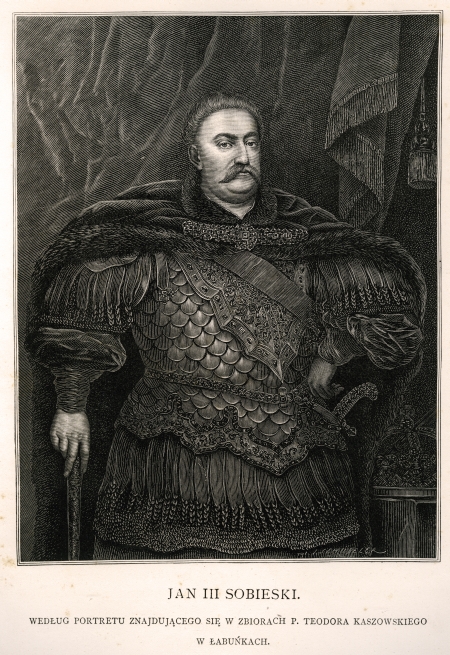
At the occasion of Stefan Batory’s four-hundredth birth anniversary and two-hundred-fiftieth anniversary of the Relief of Vienna, in 1933 the Polish Army Museum in Warsaw hosted a large exhibition accompanied by a catalogue. Similar to a majority of such publications in the pre-war Poland, unfortunately the exhibition catalogue was modestly illustrated, as it contained only two full-plate black-and-white reproductions depicting portraits of two kings, Stefan Batory and Jan III Sobieski.
The catalogue reproduced Sobieski’s period oil painting (140 x 107 cm) by an anonymous but high-quality artist, accompanied by the following description: “Below the waist, directed in ¾ to the left, with the right hand resting on a baton, the left hand placed against the hip; wearing a karacena with brassards and a classic bottom part, a huge and profusely decorated bevor reaching the waist, a gem-studded karabela (type of Polish sabre) with a hilt [!], a red baldric, a blue sash running from the right shoulder to the left side, a red delia coat lined with dark fur and buckled on the chest with a large clasp. A crown and a sceptre on the table”. At that time the described painting remained a private property of Count Zygmunt Kaszowski, bearer of the Janina coat of arms, son of Teodor. Teodor Kaszowski, a member of the Volhynian Deputation, a Maltese commander and the landowner of Łabuńki, died in Warsaw in 1896. When in 1883 in Congress Poland Józef Łoski published his epoch-making work Jan Sobieski, jego rodzina, towarzysze broni i współczesne zabytki [Jan Sobieski, his family, comrades-in-arms, and contemporary monuments], the king’s portrait was still in the Kaszowski family estate of Łabuńki. Fortunately included in the publication, it was reproduced in the woodcut technique by outstanding Warsaw artist Julian Schübeler.
The landed property of Łabuńki, composed of a village and a manor farm in the former county of Zamość, in the eighteenth century was subsequently owned by the Wielhorski, Grzebski, Karnicki and eventually the Kaszowski families. The local palace contained a large family archive and a library comprising (according to data from 1884) over 4 thousand volumes, rich in panegyrics and manuscripts of heraldic and historical content. The property suffered in World War I, as nearly the entire library collection was plundered by German and Austrian troops. The landlord Zygmunt Kaszowski managed to transport to the Volhynia region his collection of paintings and works of art. Its later fate is unknown. The whole palace interior and its fittings were ravaged and burnt.
A part of the Łabuńki collection must have been preserved however, since Zygmunt Kaszowski loaned to the 1933 exhibition in Warsaw the oil portrait of Jan III Sobieski together with January Suchodolski’s oil painting entitled Tabor polski atakowany przez Tatarów [A train of Polish wagons under attack by Tatars]. The king’s portrait was probably lost in the course of World War II, as all its traces vanished after 1945. Although exhibitions dedicated to Old Polish portraits and the round anniversary of the Relief of Vienna (1983) were numerous in Poland, there is no mention of the piece in any post-war exhibition catalogue. Its loss is the more painful that the discussed effigy of Jan III Sobieski, both impressive and majestic, was painted by a quality artist. The only charge against the work might be a somewhat imperfect foreshortening of the king’s left hand.
Julian Schübeler, based on a painting by an anonymous painter from 1675–1700: Portrait of Jan III Sobieski, woodcut, publ. 1883.
We would like to inform that for the purpose of optimisation of content available on our website and its customisation according to your needs, we use information stored by means of cookies on the Users' end devices. You can control cookies by means of your Internet browser settings. Further use of our website without change of the browser settings means that you accept the use of cookies. For more information on cookies used by us and to feel comfortable about this subject, please familiarise yourselves with our Privacy Policy.
✓ I understand